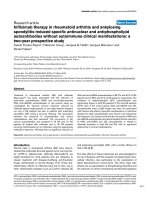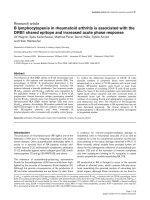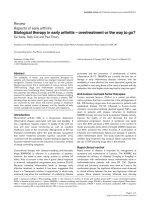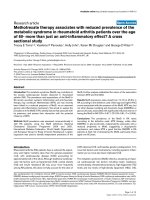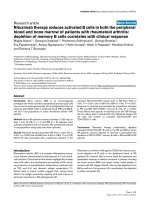Báo cáo y học: " Rescue therapy in septic shock – is terlipressin the last frontie" ppt
Bạn đang xem bản rút gọn của tài liệu. Xem và tải ngay bản đầy đủ của tài liệu tại đây (35.34 KB, 2 trang )
Page 1 of 2
(page number not for citation purposes)
CI = cardiac index; MAP = mean arterial pressure.
Available online />Abstract
Use of terlipressin, an analogue of vasopressin, can be considered
in septic shock patients with intractable hypotension and high
cardiac output in whom fluid resuscitation and high-dose
conventional catecholamines have failed. The effects of this agent
on organ function are poorly evaluated in humans. The limited
number of patients evaluated precludes any analysis of adverse
outcomes and prognosis.
In the previous issue of Critical Care, Rodriguez-Nunez and
coworkers [1] report their experience with terlipressin in 16
children with refractory septic shock. Over the past few years
there has been much interest in the use of terlipressin in such
settings, both in adults [2-6] and children [7-10].
Septic shock is a form of distributive shock characterized by
arteriolar and venous vasodilatation. The objectives of
treatment are twofold [11]: to maintain oxygen delivery above
a critical threshold and to increase mean arterial pressure
(MAP) to a level that allows distribution of cardiac index (CI)
sufficient for adequate organ perfusion. Among the catechol-
amines, noradrenaline (norepinephrine) and dopamine are
often favoured. However, vascular responsiveness to cate-
cholamines diminishes over time, and patients may die in
states of intractable shock [12]. The vascular hyporeactivity to
catecholamines is caused, among other mechanisms, by
excessive nitric oxide formation associated with an activation
of ATP-sensitive potassium channels and reduction in calcium
entry through voltage-gated calcium channels [13]. Thus, the
search for alternative vasopressors is of high priority.
Vasopressin mediates vasoconstriction via V
1
receptors and
increases intracellular calcium concentration. This action is
not impaired during sepsis, and vasopressin has been shown
to be effective in reversing catecholamine-resistant hypo-
tension in patients with septic shock [14]. Vasopressin is not
available in all countries, and some hospital pharmacies
dispense lysine vasopressin, or terlipressin (Glypressine
®
;
Ferring Company, Berlin, Germany), which is the form of
vasopressin that is present in pig.
The first clinical trial evaluating the efficacy of terlipressin in
septic shock was performed in a small case series of eight
patients [2]. Terlipressin was administered as a single bolus of
1 mg (the dosage used in gastroenterological indications) in
patients with septic shock refractory to catecholamine/
hydrocortisone/methylene blue. A significant improvement in
blood pressure was achieved in these patients during the first
5 hours. Cardiac output was reduced, which might have
impaired oxygen delivery; no other adverse effect was observed.
Partial or total weaning from catecholamines was possible.
Another study was conducted in 15 patients with catechol-
amine-dependant septic shock (noradrenaline ≥0.6 µg/kg per
min) [5]. An intravenous bolus of 1 mg terlipressin was
followed by an increase in MAP and a significant decrease in
CI. Oxygen delivery and consumption were significantly
decreased. Gastric mucusal perfusion was evaluated by laser
Doppler flowmetry and was increased after administration of
terlipressin.
In the latter study, rather low doses of noradrenaline were
used (0.75 µg/kg per min at baseline) and the study patients
could not really be considered ‘catecholamine resistant’ [5].
Such patients were evaluated by our group [4]. Terlipressin
was used in patients with intractable hypotension despite use
of >2.0 µg/kg per min noradrenaline and 25 µg/kg per min
dopamine. In these ‘catecholamine-resistant’ patients,
terlipressin (1 or 2 mg intravenously) was able to reverse the
intractable hypotension, with a concomitant decrease in heart
rate and CI. In this study oxygen delivery and consumption
were significantly decreased during use of terlipressin. A
similar observation was reported in sheep [15]. We cannot
rule out worsened oxygen extraction and utilization in our
Commentary
Rescue therapy in septic shock – is terlipressin the last frontier?
Marc Leone and Claude Martin
Intensive Care Unit and Trauma Center, Nord University Hospital, Marseilles School of Medicine, Marseilles, France
Corresponding author: Claude Martin,
Published: 21 March 2006 Critical Care 2006, 10:131 (doi:10.1186/cc4863)
This article is online at />© 2006 BioMed Central Ltd
See related research by Rodriguez-Nunez et al. in issue 10.1 [ />Page 2 of 2
(page number not for citation purposes)
Critical Care Vol 10 No 2 Leone and Martin
patients. The terlipressin-induced fall in oxygen delivery and
consumption emphasizes the need to monitor CI closely
when this drug is used in patients with sepsis. The additional
use of a potent positive inotropic drug such as dobutamine is
of interest. Despite a decrease in oxygen delivery and
consumption, lactate concentrations remained constant or
even decreased during use of terlipressin [4,6,15]. Such a
dependence on oxygen supply is usually associated with
some degree of tissue ischaemia and a subsequent increase
in lactate concentration. We speculated that terlipressin
could have modulated the hyperdynamic metabolic response
during endotoxaemia and exerted anti-inflammatory effects,
thereby decreasing the oxygen needs of tissues [4].
Experience with terlipressin in children is also limited. Four
studies were published prior to the start of 2006 [7-10]. Like
the ones conducted in adults, these studies have serious
limitations, including administration of the drug in desperate
cases and evaluation of small numbers of patients. One
serious concern is raised by the high incidence of ischaemia
during terlipressin administration [1]. In nine patients without
signs of ischaemia, five developed skin and/or limb
ischaemia. Interestingly, in seven other patients with signs of
ischaemia before use of terlipressin, signs of ischaemia
improved in four of them. Such a heterogeneous response is
intriguing and emphasizes the needed (at least in adults) for
close monitoring of CI and systemic vascular resistance.
Another important consideration with use of terlipressin is its
effects on regional haemodynamics and organ function. At
present the evidence is limited. Renal function and gastric
mucosal perfusion are improved [4-6], but no control groups
were evaluated in two of these studies [4,5]. Therefore,
further studies are need to determine the safety of terlipressin
when used in patients with septic shock.
In conclusion, use of terlipressin may be considered in
patients with (truly) refractory septic shock despite adequate
fluid resuscitation and high-dose conventional vasopressors
[16]. If terlipressin is a last resort therapy, then the
advantages (increased MAP, and improved renal function and
perfusion of gastric mucosa) should be weighed against
unresolved issues, namely effects on other organs and risk for
severe and irreversible ischaemia, not to mention the
(unknown) effects on the microcirculation.
Competing interests
The authors declare that they have no competing interests.
References
1. Rodriguez-Nunez A, Lopez-Herce J, Gil-Anton J, Hernandez A,
Rey C. Rescue treatment with terlipressin in children with
refractory septic shock: a clinical study. Crit Care 2006, 10:
R20
2. O’Brien A, Clapp L, Singer M: Terlipressin for norepinephrine-
resistant septic shock. Lancet 2002, 359:1209-1210.
3. Fellahi JL, Benard P, Daccache G, Mourgeon E, Gerard JL:
Vasodilatory septic shock refractory to catecholamines:is
there a role for terlipressin? Ann Fr Anesth Reanim 2003, 22:
631-634.
4. Leone M, Albanese J, Delmas A, Chaabane W, Garnier F, Martin
C: Terlipressin in catecholamine-resistant septic shock
patients. Shock 2004, 22:314-319.
5. Morelli A, Rocco M, Conti G, Orecchioni A, De Gaetano A,
Cortese G, Coluzzi F, Vernaglione E, Pelaia P, Pietropaoli P:
Effects of terlipressin on systemic and regional haemody-
namics in catecholamine-treated hyperkinetic septic shock.
Intensive Care Med 2004, 30:597-604.
6. Albanese J, Leone M, Delmas A, Martin C: Terlipressin or norep-
inephrine in hyperdynamic septic shock: a prospective, ran-
domized study. Crit Care Med 2005, 33:1897-1902.
7. Matok I, Vard A, Efrati O, Rubinstein M, Vishne T, Leibovitch L,
Adam M, Barzilay Z, Paret G: Terlipressin as rescue therapy for
intractable hypotension due to septic shock in children. Shock
2005, 23:305-310.
8. Rodriguez-Nunez A, Fernandez-Sanmartin M, Martinon-Torres F,
Gonzalez-Alonso N, Martinon-Sanchez JM: Terlipressin for cate-
cholamine-resistant septic shock in children. Intensive Care
Med 2004, 30:477-480.
9. Matok I, Leibovitch L, Vardi A, Adam M, Rubinstein M, Barzilay Z,
Paret G: Terlipressin as rescue therapy for intractable
hypotension during neonatal septic shock. Pediatr Crit Care
Med 2004, 5:116-118.
10. Peters MJ, Booth RA, Petros AJ: Terlipressin bolus induces sys-
temic vasoconstriction in septic shock. Pediatr Crit Care Med
2004, 5:112-115.
11. Hollenberg SM, Ahrens TS, Annane D, Astiz ME, Chalfin DB,
Dasta JF, Heard SO, Martin C, Napolitano LM, Susla GM, et al.:
Practice parameters for hemodynamic support of sepsis in
adult patients: 2004 update. Crit Care Med 2004, 32:1928-
1948.
12. Goncalves JA Jr, Hydo LJ, Baries PS: Factors influencing
outcome of prolonged norepinephrine therapy for shock in
critical surgical illness. Shock 1998, 10:231-236.
13. Takakura K, Taniguchi T, Muramatsu I, Takeuchi K, Fukuda S:
Modification of alphal-adrenoceptors by peroxynitrite as a
possible mechanism of systemic hypotension in sepsis. Crit
Care Med 2002, 30:894-899.
14. Delmas A, Leone M, Rousseau S, Albanese J, Martin C: Clinical
review: vasopressin and terlipressin in septic shock patients.
Crit Care Med 2005, 9:212-222.
15. Westphal M, Stubbe H, Sielenkamper AW, Borgulya R, Van Aken
H, Ball C, Bone HG: Terlipressin dose response in healthy and
endotoxemic sheep:impact on cardiopulmonary performance
and global oxygen transport. Intens Care Med 2003, 29:301-
308.
16. Dellinger RP, Carlet JM, Masur H, Gerlach H, Calandra T, Cohen
J, Gea-Banacloche J, Keh D, Marshall JC, Parker MM, et al.: Sur-
viving Sepsis campaign guidelines for management of severe
sepsis and septic shock. Crit Care Med 2004, 32:858-872.


